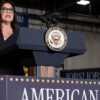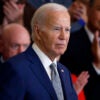Since returning to the White House on Jan. 20, President Donald Trump has unleashed a storm of executive orders, a great many of which have been halted or blocked—not by the now-Republican-controlled Congress, but by federal district courts. According to numbers compiled by the Harvard Law Review, U.S. district courts have issued more sweeping injunctions against Trump in the past two months than they have against three former presidents over their entire terms.
Since Jan. 20, lower courts have imposed 15 nationwide injunctions against the Trump administration, compared to what the Harvard Law Review recounts as six over the course of George W. Bush’s eight-year presidency, 12 over the course of Barack Obama’s eight years in the White House, and 14 during Joe Biden’s single four-year term.
During his first term, Trump was subjected to 64 nationwide injunctions. If inferior courts continue issuing nationwide injunctions against the Trump administration at the current rate (15 for every two months in office), then the second Trump administration will have accumulated 360 nationwide injunctions by the time the president leaves office—and a grand total of 424 over the course of both of Trump’s terms. However, there have been a total of over 45 rulings or more targeted injunctions leveled against the second Trump administration overall, according to The New York Times.
The Harvard Law Review’s tally (published in 2024) also noted the increased partisanship of the federal judiciary. Of the six injunctions imposed against Republican Bush, half came from judges appointed by Democrats and half from judges appointed by Republicans. Of the 12 injunctions imposed against Democrat Obama, seven (less than 60%) were issued by judges appointed by Republicans. Of the 64 injunctions Trump’s first Republican administration was slapped with, 92.2% were issued by judges appointed by Democrats. All—100%—of the 14 injunctions issued against Democrat Biden came from Republican-appointed judges.
Almost a year before Trump’s return to the White House, the Harvard Law Review also warned against the practice of “judge shopping,” essentially looking at the partisan leanings of various federal judges and bringing a complaint in a given district based on a judge’s presumed political leanings. During the first Trump administration, more injunctions were issued against the president by federal district court judges in deep-blue California than by judges in any other state.
The second Trump term is seemingly witnessing a repeat of this effect. The Washington Stand conducted an analysis of all the lawsuits either already heard or pending a ruling or injunction at the district court level against the second Trump administration, disregarding the handful of cases being overseen by federal magistrate judges. Of the 69 district court judges presiding over cases involving the Trump administration, 21 were appointed by Republican presidents: two by Ronald Reagan, one by George H.W. Bush, eight by George W. Bush, and 10 by Trump himself. Already, several of those Republican-appointed judges have issued injunctions or rulings against Trump’s executive orders and actions. The other 48 district court judges overseeing complaints against the Trump administration were appointed by Democrats: seven by Bill Clinton, 20 by Obama, and 21 by Biden.
In its analysis, the Harvard Law Review observed that “the extreme use of nationwide injunctions during the Trump Administration could reflect judicial responsiveness to the unprecedented degree to which President Trump tested the limits of presidential power.” However, the legal journal added that “in the Biden years, judges appear to be ordering vacatur in cases where plaintiffs requested an injunction.”
An order of vacatur is binding only on the agency to which it is directed—as opposed to nationwide injunctions, which are, as the name suggests, binding nationwide and enforceable by holding violators in contempt—and simply vacates a rule, declaring that it shall have no legal effect.
The Harvard Law Review continued, “Whether the falling rate of injunctions from the Trump to the Biden Administration reflects a decrease in abuses of executive power, judicial responsiveness to growing criticism of the nationwide injunction, or the replacement of some injunctions with the ‘lesser remedy’ of vacatur, the decrease should not mislead: district court judges appear to be striking down executive policies of opposing administrations with unprecedented frequency.”
The growing use of nationwide injunctions by inferior courts, the prestigious legal journal warned, necessarily has a chilling effect on the development of law and precedent. When several inferior courts of different jurisdictions issue conflicting rulings, the matter often winds up at the U.S. Supreme Court, where a definitive standard is set for addressing similar issues going forward. However, nationwide injunctions halt the continued challenging of executive orders, executive actions, or laws, since, as the Harvard Law Review pointed out, various other inferior courts simply refuse to take up related cases, determining that there can be no demonstration of injury in fact while the nationwide injunctions are in place.






























